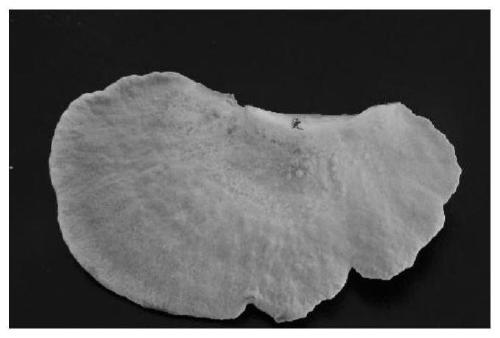Novel piptoporus solonjensis strain, culture method based on mushroom bran matrix and application of novel piptoporus solonjensis strain
A cultivation method and tube-hole technology, which are applied in the field of rare edible fungi and their cultivation, can solve the problems of poor cultivation effect traits and harvest rate, high cultivation method cost, etc.
- Summary
- Abstract
- Description
- Claims
- Application Information
AI Technical Summary
Problems solved by technology
Method used
Image
Examples
Embodiment 1
[0063] On July 18, 2015, Mo Weipeng and Feng Jiaqi obtained a fungal fruiting body specimen (HMGIM-A150751) of the genus Piptoporus during the investigation of wild macrofungal resources in West Tianmu, Tianmu Mountain National Nature Reserve, Zhejiang, 2018 On November 20, 2011, its pure culture was preserved in the China Center for Type Culture Collection (CCTCC for short), the address is: Mount Luojia, Bayi Road, Wuchang District, Wuhan City, Hubei Province, and the preservation number is CCTCC NO: M 2018756.
[0064] wild fruiting body figure 1 shown.
Embodiment 2
[0066] The sample and pure culture of embodiment 1 are carried out molecular identification identification, and the procedure is as follows:
[0067] Sampling the fruiting body collected in the wild to obtain its bacterial flesh tissue, cultivating the pure culture with cetropol membrane-PDA medium to obtain fresh mycelium, drying at low temperature (40°C), grinding with liquid nitrogen, using The Ezup column type fungal genome DNA extraction kit (Sangon Bioengineering (Shanghai) Co., Ltd.) was used to extract the DNA genome, and the obtained DNA solution (DNA template) was refrigerated at -20°C for later use.
[0068] ITS-PCR experiments were carried out by using the universal primers ITS1 / ITS4 (ITS1: TCCGTAGGTGAACCTGCGG, ITS4: TCCTCCGCTTATTGATATGC, synthesized by Sangon Bioengineering (Shanghai) Co., Ltd.) for the ribosomal intergenic region of fungi. ITS1 is primer 1, and ITS4 is primer 2. The amplification was carried out on a Biometra PCR instrument, and the composition o...
Embodiment 3
[0073] 1. The cultivation medium is as follows (if no special instructions, all are in weight percentage):
[0074] 1. Culture medium for separating mother species: 20% of sawdust bran juice, 80% of comprehensive PD, and 2% of agar.
[0075] Comprehensive PD medium: potato 20%, glucose 2%, potassium dihydrogen phosphate 0.3%, magnesium sulfate 0.15%, vitamin B1 trace, and the rest is water.
[0076] 2. Medium for the production of mother seeds: 20% potato, 2% glucose, 1% peptone, 2% agar, 0.3% potassium dihydrogen phosphate, 0.15% magnesium sulfate, trace amounts of vitamin B1, and the rest is water.
[0077] 3. Raw seed material: 93% to 94% (sorghum, barley, barley or mixture), 5% sawdust, 1 to 2% calcium carbonate.
[0078] 4. The production seed materials include: 38%~42% cottonseed hulls, 36%~40% sawdust, 18%~20% bran, 1%~2% calcium carbonate.
[0079] 5. Cultivation materials include: 30-55% fungus chaff, 15%-30% cottonseed hulls, 15%-25% corn cobs, 12% wheat bran, 2% c...
PUM
 Login to View More
Login to View More Abstract
Description
Claims
Application Information
 Login to View More
Login to View More - R&D Engineer
- R&D Manager
- IP Professional
- Industry Leading Data Capabilities
- Powerful AI technology
- Patent DNA Extraction
Browse by: Latest US Patents, China's latest patents, Technical Efficacy Thesaurus, Application Domain, Technology Topic, Popular Technical Reports.
© 2024 PatSnap. All rights reserved.Legal|Privacy policy|Modern Slavery Act Transparency Statement|Sitemap|About US| Contact US: help@patsnap.com










